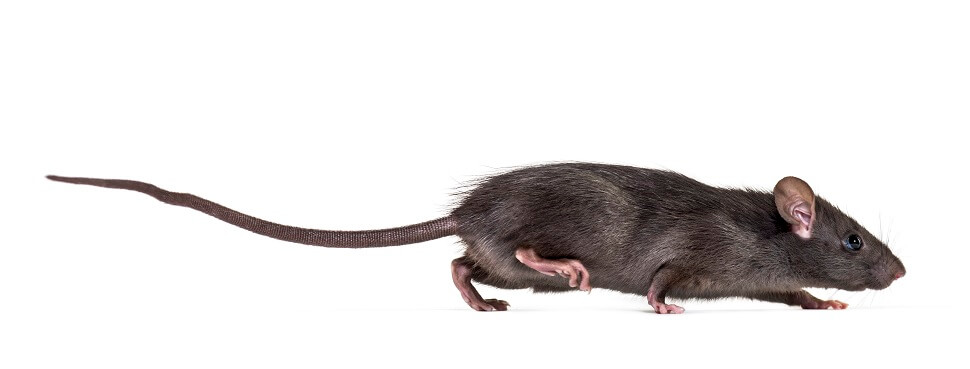
No one likes to find that their home or business is infested with any pest, but roof rats can be one of the worst. Thought to be of Southeast Asian origin, these rats and now worldwide and very common in coastal states like California. These pests can cause extensive structural damage to your property, but are California roof rats dangerous? As with any rodent pest, roof rats can serve as dangerous disease carriers that can put your family, customers, or employees at risk. At Insight Pest Management, we understand these rodents and offer you a closer look into their appearance, risk factors, elimination, and prevention.
Key takeaways
- Roof rats, also known as black rats or ship rats, can cause extensive structural damage to your property.
- Roof rats are dangerous disease carriers, posing risks to your family, customers, or employees.
- Roof rats are large, thin rodents with pointed noses, large eyes, and scaly tails.
- Signs of infestation include droppings, rub marks, gnaw marks, and electrical disruption.
What are roof rats?
Roof rats, also known as black rats or ship rats, get their name from the fact they like to seek shelter at higher elevations within a structure, such as your roof or attic. While not the largest rat in our area, the roof rat, once established in your home or business, can cause extensive damage in a short time frame.
What do roof rats look like?
Roof rats are smaller than the Norway rats by a couple of inches, but their appearance will still make you take notice. Here we take a closer look at their size and general appearance, as well as their nesting locations and where you can expect to see them.
Size
A mature adult can be 16 inches in length, with 6-8 inches making up the main body and a 6–8-inch tail. They typically weigh between 5-9 ounces but can be as large as 12 ounces.
Appearance
Roof rats are large, thin rodents with large eyes and ears, a pointed nose, and a long, scaly tail. They are brown and black in color with a gray, white, or black belly. Their tail is scaly in nature, with no hair.
Nesting areas
Unlike other rats, roof rats are not good swimmers, so you are unlikely to find these rodents near water. However, they make up for their lack of swimming ability with the fact that they are agile climbers, able to traverse walls, utility lines, fences, and much more. They are most often found in attics, cabinets, false ceilings, and inside walls. This is where they will nest. Female roof rats are very prolific breeders, often producing more than 40 new rats a year. These rodents are nocturnal creatures and are most active at night.
Dangers of roof rats
Roof rats are dangerous pests in a number of ways. Once these rodents find their way into your property, they will chew through everything. This includes structural wood and wiring, which can increase the risk of structural instability as well as the risk of fires due to exposed wires. In addition, when they settle in your home, their urine and droppings can contaminate food and soak the insulation, leading to potential food contamination and the spread of germs and disease. In addition, these rodents can bring in fleas and other parasites that can affect you, your family, and your pets.
Signs of infestation
While seeing a live rodent is obviously your best sign of an infestation, there are many signs that can show you are sharing your home with roof rats before you ever really see their presence. These can include the presence of droppings. These droppings measure around half an inch in length and have a pointed end. Rats can also produce greasy-looking rub marks along walls or other areas of your property that they travel across. In addition, you may see gnaw marks on wood or food products, hear signs of their movement in your ceiling or walls, or experience electrical disruption or flickering of lights when wiring is damaged.
How to get rid of roof rats
If you suspect a roof rat infestation, it is important to contact a professional residential pest control team, like the team at Insight Pest Management, that will conduct a thorough inspection and create an individualized roof rat removal and treatment plan.
Keeping your home free from roof rats
Preventing roof rats from your home begins with making sure that every point of entry is addressed. For example, sealing holes or cracks with caulk. In addition, you want to trim back or remove any trees or shrubs that provide access to the roof. This is especially true of fruit trees which also provide a food source for the roof rats. Keeping garbage away from the home, as well as water dishes or bird baths is also important as these can attract rats to your property.
Eliminating roof rats today
No one wants to share their home with roof rats as they can be damaging and dangerous. The team at Insight Pest Management has a deep understanding of roof rats and their behavior. Whether you suspect you have roof rats or want to do everything you can to prevent roof rats from entering your home, our team of professionals can help. Request an appointment today and our team will help make sure your home is rodent and pest free.

